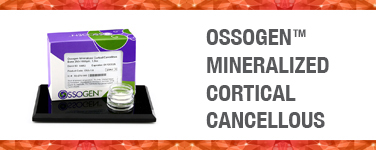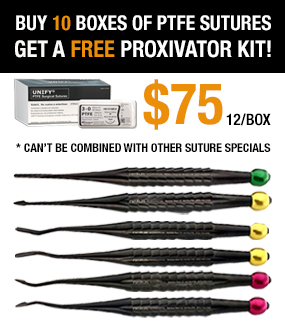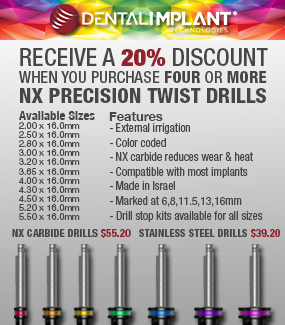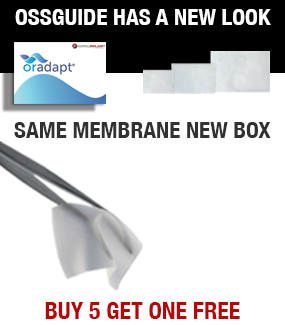Ossogen Particulate
Ossogen Cortical Cancellous Dental Bone Grafts
Discerning clinicians seeking the most reliable dental bone grafting materials will find an extensive range of regenerative products available to order at Dental Implant Technologies. Dental bone grafts come in many varieties, but for many clinicians, allografts are the ideal solution due to their high biocompatibility, naturally-derived components, safety, and results.
Our range of Ossogen™ products can provide efficient results for dental bone grafts, with both space maintenance and osteoinductive properties. Browse our selection of mineralized cortical cancellous dental bone grafting particulate and order for delivery to any practice in the United States.
Mineralized Dental Bone Grafts Enhance Bone Regeneration
Mineralized bone grafting materials can facilitate faster remodeling to ensure that dental bone grafts are predictable and precise. Ossogen™ contains a combination of mineralized cancellous and cortical bone, providing both highly rigid and softer particulates to fill alveolar ridge and sinus defects.
Mineralized dental bone grafts are highly osteoconductive. Unlike demineralized materials, this can create a scaffolding that is ideal for both space maintenance and guiding the new tissue. Both the denser and softer particles integrate with the newly formed bone. Mineralized materials do not completely remodel, as osteoclasts don’t resorb the mineral content. This provides the best of both cancellous and cortical dental bone grafts without clinicians needing to measure and mix the grafting materials chairside.
The result is a simpler procedure with better patient outcomes. Ossogen™ contains 70% cortical and 30% cancellous bone, which is the industry standard ratio when looking across a range of different products. Dental bone grafts with Ossogen™ can be secured with primary closure, or with a membrane product when primary closure isn’t possible.
Should Clinicians Choose Mineralized Solutions Over Demineralized Particulate?
Clinicians can rely on training, experience, and existing research literature to make decisions surrounding the best dental bone grafting materials
- Mineralized materials do not resorb and remodel, instead, they provide osteoconductive properties to support new tissue formation through the body’s natural process.
- Demineralized materials do resorb, and are primarily osteoinductive in nature, helping to stimulate new tissue formation.
When choosing the best material, it’s important to consider the overall needs of the patient and the specifics of the case.
Space maintenance is critical when looking at larger defects. Choosing mineralized products like Ossogen™ dental bone grafting materials will provide the necessary space maintenance so that new bone is consistent with the surrounding structures.
As an example, when repairing a large defect on the ridge, or augmenting a ridge that can’t support implants, space maintenance will be key. Without mineralized particles, the newly formed bone could be inconsistent in its size, density, and shape, which could compromise the final restoration.
Space maintenance also matters when preserving a section of the ridge after extraction. Tooth loss can compromise surrounding teeth and their bony support structures. Ensuring effective space maintenance will preserve the ridge adequately to limit long-term bone resorption and deterioration.
Osteoconductive bone grafting materials like Ossogen also help to ensure faster remodeling. When the grafting site is packed with mineralized materials, the body will require less new bone to fill the defect. This can result in faster healing in many cases. One of the most common marketing points of mineralized dental bone grafts is that healing time is reduced. If this is necessary for the desired patient outcome, then mineralized materials should be used.
Enhancing Osteoinductivity for Dental Bone Grafting
Mineralized materials can be combined with demineralized materials to provide both osteoinductive and osteoconductive properties. This would require blending of the materials chairside. Another potential route for clinicians is the formation of sticky bone, using the Choukroun PRF system.
Sticky bone combines an autologous membrane-like material with the dental bone grafting material to create a pliable putty that can be implanted at the defect site. PRF (Platelet Rich Fibrin) contains concentrated growth factors that are slowly released to make dental bone grafts more osteoinductive. PRF enhances healing time and can reduce post-surgical pain.
Options like these give clinicians the ability to completely customize a treatment to suit the needs of the patient. Choosing to develop sticky bone chairside is cost-effective and only requires a quick blood draw from the patient, followed by an automated centrifuge procedure, so it’s also convenient. The resulting material is similar in handling and healing properties to syringe-applicator dental bone grafts that contain carriers. In the long term, combining a material like Ossogen™ with autologous PRF is more cost- effective than using commercially-produced putty products.
Dental Implant Technologies Offers the Best Solutions for Dental Bone Grafts
Our team is committed to supplying the best solutions for practicing dental professionals. Our range of Ossogen™ cortical cancellous dental bone grafting materials offers cost-efficient and space-maintaining solutions for guided bone regeneration. Vials come in various sizes to eliminate wastage. All vials are packaged sterile and are single-use. Browse today and order in confidence from our secure online store.






